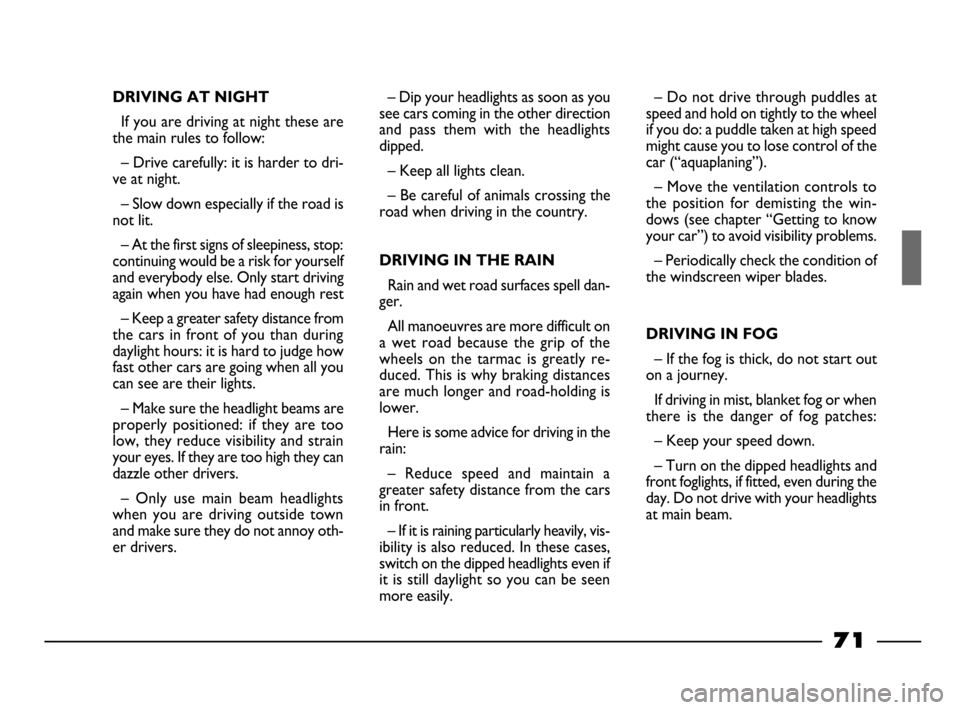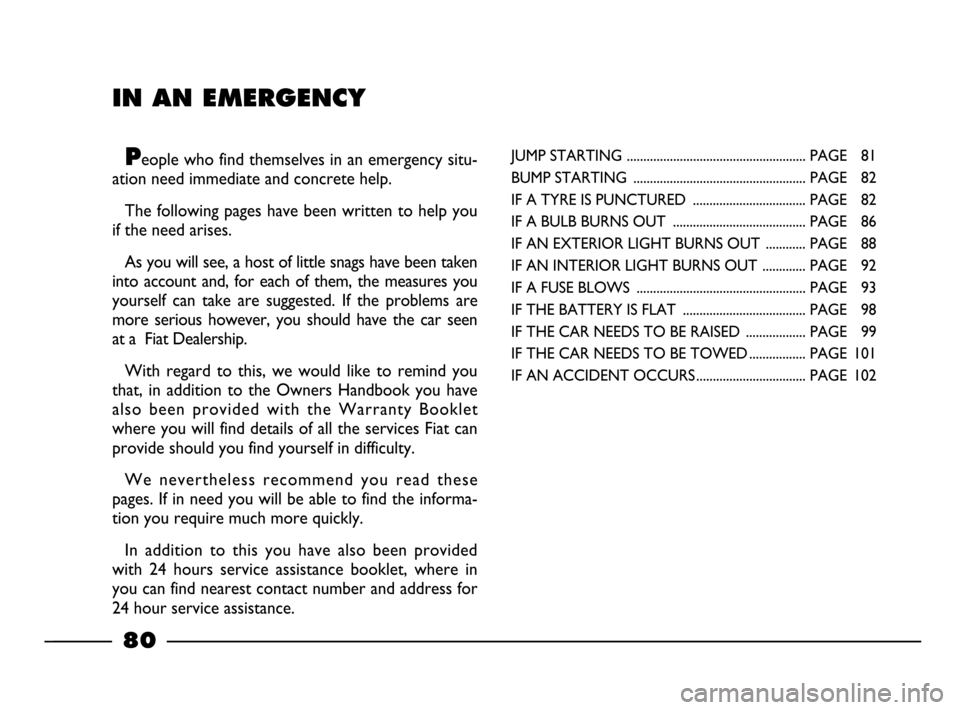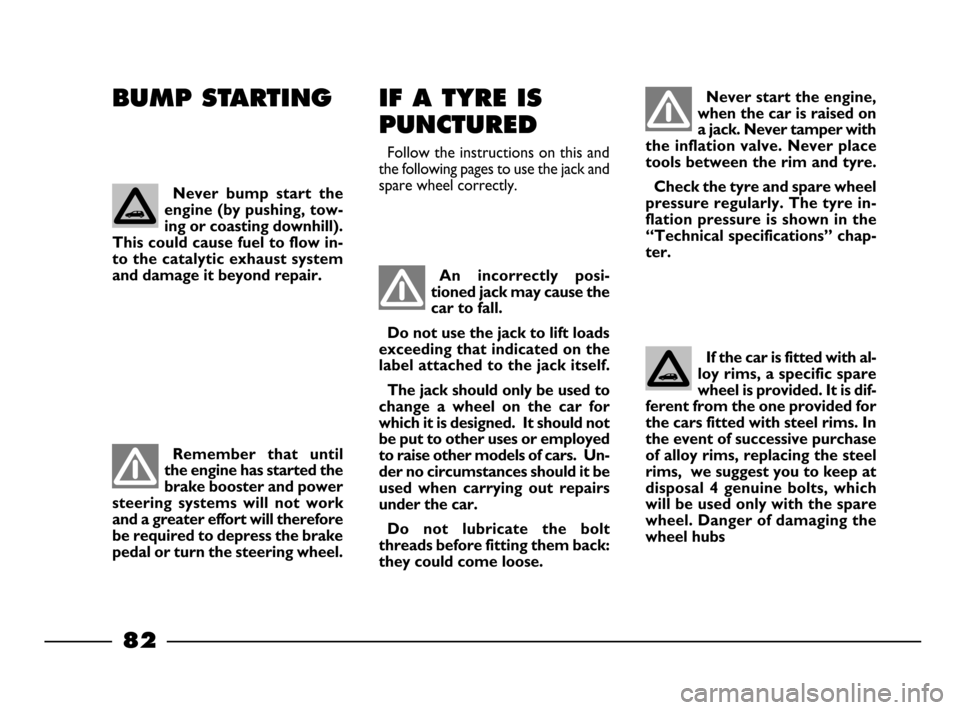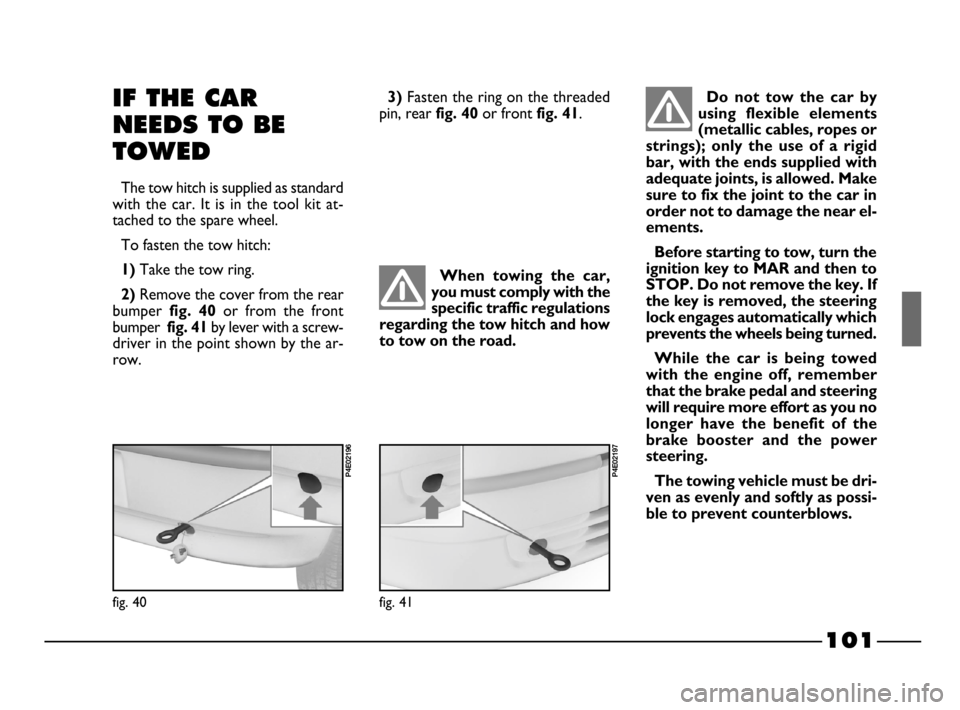tow FIAT PALIO 2003 178 / 1.G India Version User Guide
[x] Cancel search | Manufacturer: FIAT, Model Year: 2003, Model line: PALIO, Model: FIAT PALIO 2003 178 / 1.GPages: 156, PDF Size: 6.27 MB
Page 69 of 156

68
You must press the
clutch fully down to
change gear properly. It is
therefore essential that there is
nothing under the pedals. Make
sure that mats are lying flat and
do not get in the way of pedals.
SAFE DRIVING
In designing the Fiat Palio, Fiat made
every effort to offer a car able to pro-
vide driver and passengers with top
class levels of safety.
Nevertheless it is always the behav-
iour of the person at the wheel that
determines road safety.
Below you will find some simple tips
to help you travel in safety under dif-
ferent conditions.
You will no doubt be familiar with
many of them already but it will be
useful to read them all carefully.
USING THE
GEARBOX
To engage the gears, press the clutch
pedal fully down and put the gear lever
into one of the positions shown in the
diagram in
fig. 2(the diagram is also
on the gear lever knob).
To engage the reverse gear (
R), wait
that the car has stopped moving com-
pletely; from the neutral position, lift
the ring
Aof the reverse gear inhibitor
device, move the lever towards the
right side and then backwards.
fig. 2
P4E02289
IMPORTANTThe car can be put
into reverse gear when it has stopped
moving completely. With the engine
running, before engaging the reverse
gear, wait at least 2 seconds with the
clutch pedal fully down to prevent
damage and grating of the gears.
64-79 03/03/2003 06:45 PM Page 68
Page 72 of 156

71
DRIVING AT NIGHT
If you are driving at night these are
the main rules to follow:
– Drive carefully: it is harder to dri-
ve at night.
– Slow down especially if the road is
not lit.
– At the first signs of sleepiness, stop:
continuing would be a risk for yourself
and everybody else. Only start driving
again when you have had enough rest
– Keep a greater safety distance from
the cars in front of you than during
daylight hours: it is hard to judge how
fast other cars are going when all you
can see are their lights.
– Make sure the headlight beams are
properly positioned: if they are too
low, they reduce visibility and strain
your eyes. If they are too high they can
dazzle other drivers.
– Only use main beam headlights
when you are driving outside town
and make sure they do not annoy oth-
er drivers.– Dip your headlights as soon as you
see cars coming in the other direction
and pass them with the headlights
dipped.
– Keep all lights clean.
– Be careful of animals crossing the
road when driving in the country.
DRIVING IN THE RAIN
Rain and wet road surfaces spell dan-
ger.
All manoeuvres are more difficult on
a wet road because the grip of the
wheels on the tarmac is greatly re-
duced. This is why braking distances
are much longer and road-holding is
lower.
Here is some advice for driving in the
rain:
– Reduce speed and maintain a
greater safety distance from the cars
in front.
– If it is raining particularly heavily, vis-
ibility is also reduced. In these cases,
switch on the dipped headlights even if
it is still daylight so you can be seen
more easily. – Do not drive through puddles at
speed and hold on tightly to the wheel
if you do: a puddle taken at high speed
might cause you to lose control of the
car (“aquaplaning”).
– Move the ventilation controls to
the position for demisting the win-
dows (see chapter “Getting to know
your car”) to avoid visibility problems.
– Periodically check the condition of
the windscreen wiper blades.
DRIVING IN FOG
– If the fog is thick, do not start out
on a journey.
If driving in mist, blanket fog or when
there is the danger of fog patches:
– Keep your speed down.
– Turn on the dipped headlights and
front foglights, if fitted, even during the
day. Do not drive with your headlights
at main beam.
64-79 03/03/2003 06:45 PM Page 71
Page 75 of 156

74
If the engine begins to “lose its
smoothless” when travelling, continue
your journey but reduce the demands
you are making on the engine and go
to a
Fiat Dealership as soon as you
can.
When the instrument panel fuel re-
serve warning light comes on, fill up as
soon as possible. A low level of fuel
can cause an uneven supply of fuel to
the engine with the inevitable increase
in the temperature of the exhaust gas
and serious damage to the catalytic
converter.
Never run the engine with one or
more spark plugs disconnected, even
for testing purposes.
Do not warm up the engine by letting
it idle for a while before moving off un-
less the outside temperature is very low
and, even in this case, only do so for less
then 30 seconds.Do not install other heat shields and
do not remove those already fitted to
the catalytic converter and exhaust
pipe.
Do not allow anything to be sprayed
onto the catalytic converter, lambda
sensor and exhaust pipe.
Ignoring the above rules
may lead to fire.
The catalytic converter
develops high tempera-
ture during normal oper-
ation. Do not park the car on
grass, dry leaves, pine needles or
other flammable material: fire
hazard
LOOKING AFTER EMISSION
CONTROL DEVICES
The correct use of pollution control
devices not only ensures respect for
the environment but also has an effect
on the car’s performance.
Keeping these devices in good con-
dition is therefore a fundamental rule
for driving that is easy on your pock-
et and on the environment too.
The first step to take is to follow the
Service Schedule to the letter.
Use only unleaded petrol.
If you have trouble starting, do not
keep turning the ignition key for long
periods. Be especially careful to avoid
bump starting the car by pushing, tow-
ing or rolling downhill: these are all
manoeuvres that can damage the cat-
alytic exhaust. Use an auxiliary battery
for start-ups only (see “Starting with
auxiliary battery” in the chapter “In an
emergency”).
64-79 03/03/2003 06:45 PM Page 74
Page 76 of 156

75
CONTAINING RUNNING COSTS
AND POLLUTION
Tyres
Tyre pressure should be checked at
least once every four weeks: if the
pressure is too low fuel consumption
increases as the resistance to the
rolling movement of the tyre is
greater. In this state, tyre wear is in-
creased and handling suffers which will
effect safety.
Unnecessary loads
Do not travel with too much load in
the boot. The weight of the car (above
all in the urban traffic)and its trim
greatly effects consumption and sta-
bility.
Roof rack/ski rack
Remove roof racks and ski racks
from the roof of the car as soon as
they are no longer needed. These ac-
cessories reduce the aerodynamic
penetration of the car and will increase
consumption.
Electrical devices
Use electric devices for the neces-
sary time only. The heated rear win-
dow, additional lights, windscreen
wipers, heater, fan of the heating sys-
tem require large amounts of elec-
tricity and increasing the request for
power will also increase fuel con-
sumption (up to +25% when driving in
towns). Some suggestions which may help
you to keep the running costs of the
car down and lower the amount of
toxic emissions released into the at-
mosphere are given below.
GENERAL
CONSIDERATIONS
Car maintenance
The overall state of the car is an im-
portant factor which has a marked in-
fluence over fuel consumption and dri-
ving comfort and on the life span of
your car. For this reason care should
be taken to maintain your car by car-
rying out the necessary checks and
regulations in accordance with the
specifications given in the service
schedule (see sections: spark plugs,
idling, air cleaners, timing).
64-79 03/03/2003 06:45 PM Page 75
Page 77 of 156

76
Climate control system
The climate control system is an ad-
ditional load which greatly effects the
engine leading to higher(up to +20%
in average) fuel consumption. When
the temperature outside allows, use
the air vents where possible.
Spoilers
The use of optional extras, which are
not certified for specific use on the car,
may reduce the aerodynamic pene-
tration of the car and increase con-
sumption.
DRIVING STYLE
Starting
Do not warm the engine when the
car is stationary or at high or low revs:
in this way the engine will warm up
gradually increasing consumption and
emissions. You should drive off slow-
ly straight away avoiding high revs so
that the engine will warm up more
quickly.
Unnecessary actions
Avoid revving the engine when
stopped at traffic lights or before
switching off the engine and avoid
doubling the clutch as these actions
serve no purpose in modern cars and
only increase consumption and pollu-
tion.
Gear selections
As soon as the traffic and road con-
ditions allow it, shift to a higher gear.
Using a lower gear to liven up accel-
eration greatly increases consumption.
In the same way, improper use of the
higher gears will increase consump-
tion, emissions and wear and tear on
the engine.
Top speed
Fuel consumption increases consid-
erably as speed increases. For exam-
ple, when accelerating from 90 to 120
km/h, fuel consumption increases up
to approximately +30%. Your speed should be kept as even
as possible and superfluous braking
and acceleration avoided as this in-
creases both consumption and emis-
sions. A “smooth” driving style should
be adopted by attempting to anticipate
manoeuvres to avoid imminent danger
and to keep a safe distance from the
vehicle in front to avoid braking
sharply.
Acceleration
Accelerating violently increasing the
revs will greatly effect consumption
and emission; acceleration should be
gradual and not exceed the maximum
torque.
CONDITIONS OF USE
Cold starting
Very short distances and frequent
cold starting will not enable the engine
to reach optimal running temperature.
It follows, therefore, that consumption
will be higher (from +15 to +30% in
towns) as will the production of toxic
emissions.
64-79 03/03/2003 06:45 PM Page 76
Page 78 of 156

Type of snow chain
to be used
Reduced clearance snow
chains maximum projection off
wheel equal to 12 mm
Versions
1.2 EL-ELX-SPORT
1.6 16V GTX
1.9 EL-ELX
Tyres on which chains
can be fitted
165/80 R13
175/65 R14
165/80 R13
77
Traffic and road conditions
Heavy traffic and higher consumption
are synonymous: for example, when
driving slowly with frequent use of
lower gears or in towns where there
are numerous traffic lights.
Winding roads, mountain roads and
bumpy roads also have a negative effect
on consumption.
Enforced halts
During prolonged stops (traffic lights,
level crossings, etc.) the engine should
be switched off.
SNOW CHAINS
The use of snow chains is regulated
by the legislation in force in the coun-
try the car is driven in.
The chains may only be applied to
the drive wheel tyres (front wheels).
Refer to the following
table for information on
the wheels where snow
chains can be fitted. Follow the
prescriptions.
Check the tautness of the chains af-
ter driving some ten metres.
Keep your speed
down when snow
chains have been
fitted. Do not exceed 50 km/h.
Avoid potholes, do not mount
steps or kerbs and do not travel
long stretches on snow-free roads
otherwise you risk damaging
both your car and the tarmac.
64-79 03/03/2003 06:45 PM Page 77
Page 81 of 156

IN AN EMERGENCY
People who find themselves in an emergency situ-
ation need immediate and concrete help.
The following pages have been written to help you
if the need arises.
As you will see, a host of little snags have been taken
into account and, for each of them, the measures you
yourself can take are suggested. If the problems are
more serious however, you should have the car seen
at a Fiat Dealership.
With regard to this, we would like to remind you
that, in addition to the Owners Handbook you have
also been provided with the Warranty Booklet
where you will find details of all the services Fiat can
provide should you find yourself in difficulty.
We nevertheless recommend you read these
pages. If in need you will be able to find the informa-
tion you require much more quickly.
In addition to this you have also been provided
with 24 hours service assistance booklet, where in
you can find nearest contact number and address for
24 hour service assistance.JUMP STARTING ...................................................... PAGE 81
BUMP STARTING .................................................... PAGE 82
IF A TYRE IS PUNCTURED .................................. PAGE 82
IF A BULB BURNS OUT ........................................ PAGE 86
IF AN EXTERIOR LIGHT BURNS OUT ............ PAGE 88
IF AN INTERIOR LIGHT BURNS OUT ............. PAGE 92
IF A FUSE BLOWS ................................................... PAGE 93
IF THE BATTERY IS FLAT ..................................... PAGE 98
IF THE CAR NEEDS TO BE RAISED .................. PAGE 99
IF THE CAR NEEDS TO BE TOWED ................. PAGE 101
IF AN ACCIDENT OCCURS ................................. PAGE 102
80
80-103 03/03/2003 06:49 PM Page 80
Page 83 of 156

82
BUMP STARTING IF A TYRE IS
PUNCTURED
Follow the instructions on this and
the following pages to use the jack and
spare wheel correctly.
Remember that until
the engine has started the
brake booster and power
steering systems will not work
and a greater effort will therefore
be required to depress the brake
pedal or turn the steering wheel.
An incorrectly posi-
tioned jack may cause the
car to fall.
Do not use the jack to lift loads
exceeding that indicated on the
label attached to the jack itself.
The jack should only be used to
change a wheel on the car for
which it is designed. It should not
be put to other uses or employed
to raise other models of cars. Un-
der no circumstances should it be
used when carrying out repairs
under the car.
Do not lubricate the bolt
threads before fitting them back:
they could come loose.
Never start the engine,
when the car is raised on
a jack. Never tamper with
the inflation valve. Never place
tools between the rim and tyre.
Check the tyre and spare wheel
pressure regularly. The tyre in-
flation pressure is shown in the
“Technical specifications” chap-
ter.
Never bump start the
engine (by pushing, tow-
ing or coasting downhill).
This could cause fuel to flow in-
to the catalytic exhaust system
and damage it beyond repair.
If the car is fitted with al-
loy rims, a specific spare
wheel is provided. It is dif-
ferent from the one provided for
the cars fitted with steel rims. In
the event of successive purchase
of alloy rims, replacing the steel
rims, we suggest you to keep at
disposal 4 genuine bolts, which
will be used only with the spare
wheel. Danger of damaging the
wheel hubs
80-103 03/03/2003 06:49 PM Page 82
Page 84 of 156

83
1. STOP THE CAR
– Stop the car in a position that is not
dangerous for oncoming traffic where
you can change the wheel safely. The
ground should be flat and adequately
firm. If you have to change the wheel
at night, choose a lit area if possible.
– Turn the engine off and pull up the
handbrake.
– Engage first or reverse gear.
– Alert other drivers that the car is
stationary in compliance with local
regulations: hazard warning lights,
warning triangle etc.
Any passenger should get out and
wait as far away as possible from the
dangers of traffic.
If the road is sloping or bumpy, place
wedges or other suitable material un-
der the wheels to prevent the car from
moving.
2. TAKE OUT THE TOOLS,
JACK AND SPARE WHEEL
They are in the boot.
The tool bag is secured to the inter-
nal boot wall by proper belts,
fig. 2;
to take it out, lift the adhesive strip of
the belts. The bag contains: the jack
A-
fig. 3
, the jack operating handle B, the
wheel bolt wrench
C, the tow hitch D
and the screwdriver E.
fig. 2
P4E02373
fig. 4
P4E02375
fig. 3
P4E02374
– Lift the carpet covered flap.
– Loosen the fastener
A-fig. 4and
take the spare wheel.
80-103 03/03/2003 06:49 PM Page 83
Page 102 of 156

101
Do not tow the car by
using flexible elements
(metallic cables, ropes or
strings); only the use of a rigid
bar, with the ends supplied with
adequate joints, is allowed. Make
sure to fix the joint to the car in
order not to damage the near el-
ements.
Before starting to tow, turn the
ignition key to MAR and then to
STOP. Do not remove the key. If
the key is removed, the steering
lock engages automatically which
prevents the wheels being turned.
While the car is being towed
with the engine off, remember
that the brake pedal and steering
will require more effort as you no
longer have the benefit of the
brake booster and the power
steering.
The towing vehicle must be dri-
ven as evenly and softly as possi-
ble to prevent counterblows.IF THE CAR
NEEDS TO BE
TOWED
The tow hitch is supplied as standard
with the car. It is in the tool kit at-
tached to the spare wheel.
To fasten the tow hitch:
1)Take the tow ring.
2) Remove the cover from the rear
bumper
fig. 40or from the front
bumper
fig. 41by lever with a screw-
driver in the point shown by the ar-
row.
fig. 40
P4E02196
fig. 41
P4E02197
When towing the car,
you must comply with the
specific traffic regulations
regarding the tow hitch and how
to tow on the road.
3)Fasten the ring on the threaded
pin, rear
fig. 40or front fig. 41.
80-103 03/03/2003 06:49 PM Page 101